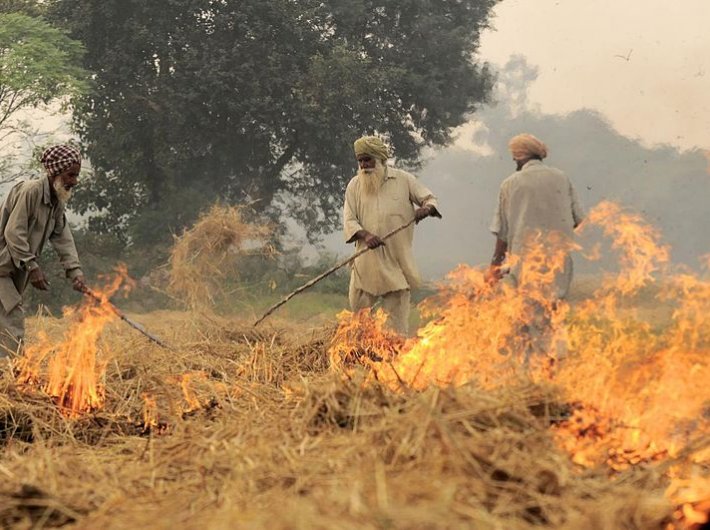Stubble can be put to commercial use, which will help eliminate the problem of farmers burning it to clear their fields.
The burning of stubble, the cut stalks left sticking out of the ground after the grain is harvested, has largely been blamed for the smog that has enveloped north India and left people gasping for breath. However, stubble can be put to commercial use and once that happens, the annual smog problem could be resolved.
The problem of stubble burning is acute in the states of Haryana and Punjab, where farmers set fire to the stalks to clear the field and start the process of planting the next crop. The use of machines called “Combines” for harvesting leaves stalks all over the field and burning is the quickest, easiest and the most economic option for farmers.
The winds carry the thick smoke from the burning of stubble to different parts of north India and every winter sees Delhi covered in smog.
In November 2016 when the smog was troubling Delhi, well known agri-scientist MS Swaminathan had said paddy straw can be used for making animal feed, cardboard, paper and other products.
“I have told the prime minister how we can make use of paddy straw instead of burning it. You cannot ask a farmer to stop burning paddy straw as he has to prepare his field for the next crop. You must find a mechanism to commercialise it,” Hindustan Times quoted Swaminathan as saying.
One of the biggest benefits of not burning stubble is reduced wind and water erosion.
Stubble cover reduced the erosive effects of water by reducing the impact of raindrops on the soil surface and decreasing run off and its velocity, said an article in the Graham Centre for Agricultural Innovation.
The article said that stubble increases soil moisture retention, particularly in the soil surface pre-sowing and during early crop development.
Also, there is avoidance of the smoke hazard from burning and improved conditions for plant growth
Retaining stubble may contribute to the accumulation of soil organic carbon or sequestering carbon that would potentially be lost through burning or removing stubble.
It said that there are a number of options available to manage stubble including grazing with livestock, slashing, mulching or harrowing and strategic burning. Stubble can provide a useful feed source for livestock. It is important to monitor stocking rates to ensure paddocks are not overgrazed, exposing them to erosion.
“Managing high stubble loads requires careful planning to ensure effective sowing during the following season. Stubble retention protects soil from erosion, aids soil moisture storage, through better infiltration and reduced surface runoff and lower evaporation rates. The ground cover offered by stubble may also help maintain soil structure by increasing soil microbial activity,” it said.
Punjab produces around 23 million tonnes of paddy straw and 17 million tonnes of wheat straw annually. More than 80 % of paddy straw (18.4 million tonnes) and almost 50 % wheat straw (8.5 million tonnes) produced in the state is being burnt in fields. Almost whole of paddy straw, except Basmati rice is burnt in the field to enable early sowing of next crop. Lately, the farmers have extended this practice to wheat crop also, wrote Parmod Kumar, Surender Kumar and Laxmi Joshi in alternative uses of crop stubble, which is part of the SpringerBriefs in Environmental Science book series.
They wrote that there are primarily two types of residues from rice cultivation that have potential in terms of energy—straw and husk. Although the technology of using rice husk is well established in many Asian countries, paddy straw as of now is rarely used as a source of renewable energy.
The experts suggest:
- Use of rice residue as fodder for animals
- Use of crop residue in bio thermal power plants
- Use of rice residue as bedding material for cattle
- Use of crop residue for mushroom cultivation
- Use of rice residue in paper production
- Use of rice residue for making bio gas
SS Verma writes in the Journal of Agriculture and Life Sciences that rice straw can either be used alone or mixed with other biomass materials in direct combustion, whereby combustion boilers are used in combination with steam turbines to produce electricity and heat. Technology developed includes combustion furnaces, boilers, and superheat concepts purportedly capable of operating with high alkali fuels and having handling systems which minimize fuel preparation.
The straw fuel or biofuel of biomass pellet mill machine uses corn stalk, wheat straw, rice straw, peanut shell, cob, cotton bar, soybean rod, weeds, branches, leaves, sawdust, bark and other solid wastes as raw materials.
A small amount of paddy straw is only consumed by brick kilns and paper and packaging industry. Power production from rice straw is a promising way to meet the growing demand of energy, said the article.
Straw is a competitive, alternative source of fiber for paper making to reduce the pressures on forests. Rice straw can be used not only to make paper but various paper products.
The compaction resistance and resiliency of rice straw makes it a very good packing material.
A Chinese company has invented eco-friendly material - straw based plastic - made from rice and wheat stalks and can be used in 3D printing, without sacrificing price or performance. The straw based plastic is made from dried crops straw, such as wheat straw, rice straw, corn stalk etc, mixed with plastic and plastic additives, using company's patent pending technology, wrote Verma.

